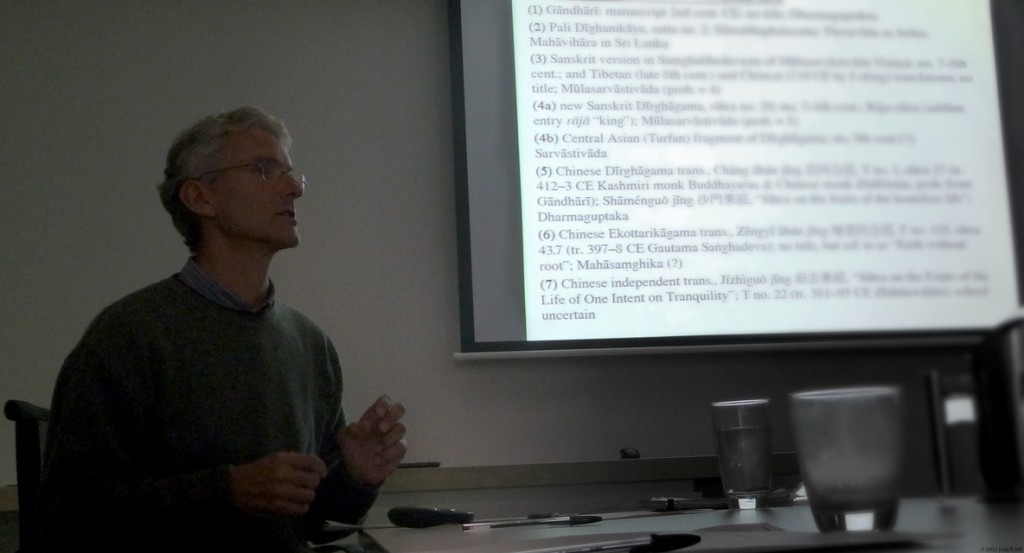Mr. Henning informs me that the Sanskrit & Tibetan is forthcoming in Dhīḥ:
Edward Henning & Vijayarāja Vajrācārya. ‘Kālacakrāvatāra of Abhayākaragupta’. kalacakra.org, 2013 [pre-press draft of Sanskrit edition].
Mr. Henning informs me that the Sanskrit & Tibetan is forthcoming in Dhīḥ:
Edward Henning & Vijayarāja Vajrācārya. ‘Kālacakrāvatāra of Abhayākaragupta’. kalacakra.org, 2013 [pre-press draft of Sanskrit edition].
Ernst Steinkellner, Helmut Krasser, Horst Lasic (eds.) Jinendrabuddhi´s Viśālāmalavatī Pramāṇasamuccayaṭīkā Chapter 2. Sanskrit Texts from the Tibetan Autonomous Region, Vols. 15/1, 15/2. Beijing & Vienna: China Tibetology Publishing House Austrian Academy of Sciences Press, 2013. 149+111 pp. ISBN-13: 978-3-7001-7134-8.
斯齐,卡热萨,斯坦因凯勒校勘 (編) 《吉年陀罗菩提《集量论》广大清净疏第二章:全二册 梵文、英文分享到》 中国藏学出版社 2013
[Publisher information updated from provided cover image, 2013/7/3. See also: Series’ official site]
Seishi Karashima. ‘Was the Aṣṭasāhasrikā Prajñāpāramitā Compiled in Gandhāra in Gāndhārī?’ Annual Report of the International Research Institute for Advanced Buddhology (ARIRIAB) at Soka University for the Academic Year 2012, vol.XVI, 2013, pp.171–188. [PDF]
This is a remarkable piece of detective work and a milestone in the study of the Mahāyāna, whether or not one thinks (as I do) that Prof. Karashima’s theory nails it. Karashima’s many years of lexicographical toil seem to have finally paid off: the earliest Chinese phonetic transcriptions from the Aṣṭasāhasrikā agree most fully with the newly found Gāndhārī fragments (for which see also Strauch 2007). And that, moreover, is merely one of many compelling indicators pointing to the composition of the text in Gandhāra.
One minor comment: the image of Dharmodgata discovering the Prajñāpāramitā written on gold plates vilīnena vaidūryeṇa — in “melted” lapis, according to Karashima (p.181) — sounds excessively fantastic. The reference is to lapis lazuli pigment, well known to medievalists as ultramarine, ‘beyond the sea’ — i.e., from Afghanistan.
四川大学中国藏学研究所(会议主办)、哈佛燕京学社(会议协办): “7至17世纪西藏历史与考古、宗教与艺术国际学术研讨会”。 中国·成都·四川大学 2013年7月13-15日。
Center for Tibetan Studies of Sichuan University & Harvard-Yenching Institute (co-conveners). ‘International Conference On Tibetan History And Archaeology, Religion And Art (7th–17th c.)’. Sichuan University, Chengdu, China, July 13–15, 2013. [official site / 2nd circular w/ abstracts]
会议召集 人:霍 巍 教授(四川大学)、范德康 教授(哈佛大学)
Conference conveners: Prof. Huo Wei (Sichuan University) & Prof. Leonard W.J. van der Kuijp (Harvard University).

Continue reading “International Conference on Tibetan History &c. (2013-7-13)”
Ulrich Timme Kragh (ed.) The Foundation for Yoga Practitioners: The Buddhist Yogācārabhūmi Treatise and Its Adaptation in India, East Asia, and Tibet. Harvard Oriental Series 75. “Available 07/22/2013”. ISBN 9780674725430.
“The present edited volume, conceived by Geumgang University in South Korea, brings together the scholarship of thirty-four leading Buddhist specialists on the Yogācārabhūmi from across the globe. The essays elaborate the background and environment in which the Yogācārabhūmi was composed and redacted, provide a detailed summary of the work, raise fundamental and critical issues about the text, and reveal its reception history in India, China, and Tibet. The volume also provides a thorough survey of contemporary Western and Asian scholarship on the Yogācārabhūmi in particular and the Yogācāra tradition more broadly.”
(Contains, among others [updated, 2013-05-01]:
H. Sakuma 佐久間秀範, ‘Remarks on the Lineage of Indian Masters of the Yogācāra School: Maitreya, Asaṅga, and Vasubandhu’, pp.330–366.
M. Delhey, ‘The Yogācārabhūmi Corpus: Sources, Editions, Translations, and Reference Works’, pp.498–561.)
Christopher D. Emms. Evidence for Two Mūlasarvāstivādin Vinaya Traditions in the Gilgit Prātimokṣa-sūtras. M.A. thesis, McMaster University, 2012. 127 pp. Open Access Dissertations and Theses, Paper 7337. [URI/PDF]
The Sanskrit prātimokṣa-sūtras contained in the Gilgit Buddhist manuscripts have been identified as belonging to the Mūlasarvāstivāda school. However, the identification of these manuscripts as Mūlasarvāstivādin texts is problematic. A key factor for determining the school affiliation of a prātimokṣa is the rule order. The Gilgit prātimokṣa-sūtras, however, differ in their rule order. In this thesis, I explore the relationship of these Gilgit prātimokṣa-sūtras to Mūlasarvāstivādin literature. […] I argue that we have evidence for two distinct Mūlasarvāstivādin Vinaya traditions within the Gilgit prātimokṣa-sūtras.
Mark Allon. ‘A Gāndhārī version of the Buddha’s Discourse on the Fruits of Living the Ascetic Life (Śrāmaṇyaphala-sūtra)’. Australasian Association of Buddhist Studies Victoria Seminar, 5th April 2013, Deakin Prime Campus, Melbourne.
The Senior collection of Gandhāran Buddhist manuscripts includes a scroll which contains a Gāndhārī version of the introductory section of the Śrāmaṇyaphala-sūtra, the Buddha’s discourse to King Ajātaśatru on the benefits of living the ascetic or holy life. The appearance of a Gāndhārī version of this interesting and popular sūtra coincides with the appearance of a second Sanskrit witness of it, namely, that included in the new Dīrghāgama manuscript, which preliminary research indicates is similar to but not identical with the Sanskrit version found among the Gilgit manuscripts. We therefore now have Indic versions of the Śrāmaṇyaphala-sūtra in Gāndhārī (albeit incomplete), Pali, and Sanskrit, a Tibetan translation and four Chinese translations, which belong to a diversity of schools and originate from different times and places. Not surprisingly the Gāndhārī sūtra is not identical to any other version, but shows a complex relationship with them. In this paper I will discuss the Gāndhārī version of the sūtra and its relationship to the parallels in other languages, the possible reasons for its popularity, and the likely reasons for its inclusion in the Senior collection.

བོད་རང་སྐྱོང་ལྗོངས་སུ་ཉར་ཚགས་བྱས་པའི་ཏ་ལའི་ལོ་མའི་དཔེ་ཆ་ཀུན་བཏུས་པར་མ།
《西藏自治区珍藏贝叶经影印大全》(共61分册)
*Facsimile Edition of Palmleaf Manuscripts in the Tibet Autonomous Region: Complete Collection. 2012(?). 61 vols.བོད་རང་སྐྱོང་ལྗོངས་སུ་ཉར་ཚགས་བྱས་པའི་ཏ་ལའི་ལོ་མའི་དཔེ་ཆ་ཀུན་བཏུས་ཀྱི་དཀར་ཆག་བསྡུས་པ།
《西藏自治区珍藏贝叶经影印大全简目》
*Facsimile Edition of Palmleaf Manuscripts in the Tibet Autonomous Region: Complete Collection. Brief Index. 2012(?).བོད་རང་སྐྱོང་ལྗོངས་སུ་ཉར་ཚགས་བྱས་པའི་ཏ་ལའི་ལོ་མའི་དཔེ་ཆ་བྲིས་མའི་རྩ་བའི་དཀར་ཆག།
《西藏自治区珍藏贝叶经总目录》(共4册)
*Master Catalogue of Palmleaf Manuscripts in the Tibet Autonomous Region. 2012(?). 4 vols.

Continue reading “Facsimile Edition of All Palmleaf MSS in the TAR (2012?)”
Martin Delhey. ‘The Textual Sources of the Mañjuśriyamūlakalpa (Mañjuśrīmūlakalpa), With Special Reference to Its Early Nepalese Witness NGMPP A39/4′. Journal of the Nepal Research Centre* vol.14, 2012, pp.55–75. ISSN 2091-0401 [downloadable with restricted access at academia.edu].
Continue reading “Delhey, Textual Sources of the Mañjuśriyamūlakalpa (2012)”